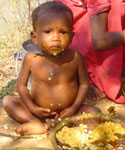Millions of people have lost their homes, livelihoods and foodgrain stocks in the lashing wind and non-stop rain that deluged coastal Orissa, in eastern India, last month. But this area has seen recurrent droughts, gradual impoverishment and starvation deaths, for a century.
It could take months, even years, for the survivors to put their lives together in a state which is synonymous with ”hunger deaths” in the mineral-rich but terribly poor hunger belt of Bolangir, Koraput and Kalahandi.
Orissa’s infant mortality rate is the highest in India (96 per 1,000 births), and as its western belt is the worst off in the state, the figures for that area could be far worse. To escape the spiral of poverty, tens of thousands of people migrate during October and November from western Orissa every year. From Bolangir and Nuapada alone an estimated 200,000 labourers migrate annually.
Rural poverty is perpetuated by skewed land distribution, a rigged market and state laws that promote exploitative monopolies in the grain and forest produce markets.
Lacking any fall-back mechanism, thousands of people migrate to work in construction sites, brick kilns or to pull rickshaws, and do odd jobs. ”Migration is often a chance to pay back a debt, retrieve a piece of mortgaged land or save up enough money for a family ceremony,” says DK Pattnaik, director of the non-governmental Development in Kantabanji.
Shatrughan Majhi, a landless Gond tribal of Lokpada village, says he is a regular migrant worker. ”We (a team of three) get 60 rupees a day to make 1,000 bricks,” says Majhi, packing up to go. This seems good money to Majhi, as back home he cannot even get half the amount for a day’s work, which comes rarely anyway.
The seasonal migrant workers trade off their health and safety as migration remains an unaccounted activity. ”Often there is no official record of the migrant worker’s whereabouts, so little scope for any kind of compensation in case of death or disability,” says BP Sharma, a human rights lawyer of Kantabanji town, a local trade centre.
The migrants’ return time during the rainy days of June is a time of great concern, local healthcare workers note. ”The biggest problem is gastro-enteric diseases,” says Dr SS Panda, head of the public health centre at Turaikala. Migration and subsequent malnutrition and infection add to the disease burden in this malaria belt, Dr Panda adds.
Some workers tend to burn themselves out as the brick kiln wages are based on the number of bricks made. The weekly meager food allowance leaves people scampering for the cheapest food. Often dinner is a meal of ”tukda” (broken) rice and some cheap vegetable. There have been several instances of deaths during migration and during journeys, notes a local field health worker.
”It is a tough life for women,” notes Pushpa Tandi, a middle-aged Dalit woman from Andalpuri, who has migrated several times to several destinations. ”Queuing up at a Government hospital means loss of half day’s work and a private clinic would mean a huge bill.” Her husband developed tuberculosis a few years back. Though he is cured he cannot do any hard work. ”We stopped migrating. My husband now makes and beats drums and we do odd jobs for a living,” says Tandi.
Health workers note that many pregnant women migrate. ”Many pregnant women enrol with us,” says Mohammad Babloo, a labour contractor at Kantabanji. Dr Panda says the total lack of antenatal care in their destinations often complicates many deliveries.
Malnutrition is another major problem for migrants as well as those left behind. Pushpa Tandi, who also works as a midwife, notes that many young mothers returning from migration are malnourished.
For the villagers of Andalpuri, the nearest public health centre at Turaikala is about 20 km away. An estimated 80 percent of the child births take place at homes. It is the local traditions that seem to help mothers.
Children who migrate lose their primary education. Those who are left with elder siblings tend to be malnourished. The worst cases of malnutrition in the village are two children left behind by their migrating parents.
Pushpa Tandi says that the old men and women left behind in the houses during the migratory season have to fend for themselves. The advance money is a great help. Those who do not get enough advance amounts wait for an odd money order of a few hundred rupees.
Tightening the belt means less food, especially so for women. ”We always eat last. But that is how it should be,” says Tandi. Anemia is rampant, especially among women, Dr Panda notes. However, he notes that that is the case for most parts of India.
When there is not enough money, the diet is rice and salt. During 1996, Andalpuri suffered famine and hunger. However, not a single man or woman in the village would talk about hunger. Such talk is considered undignified.
According to data displayed at the primary health centre, the recorded infant mortality rate in 1998 was over 85 per 1000 births and maternal mortality rate 458 per 100,000 births. Both these figure are higher than the national average of 80 and 400 respectively.
One of the poorest of Indian states, Orissa’s misery has been compounded by the cyclone.

